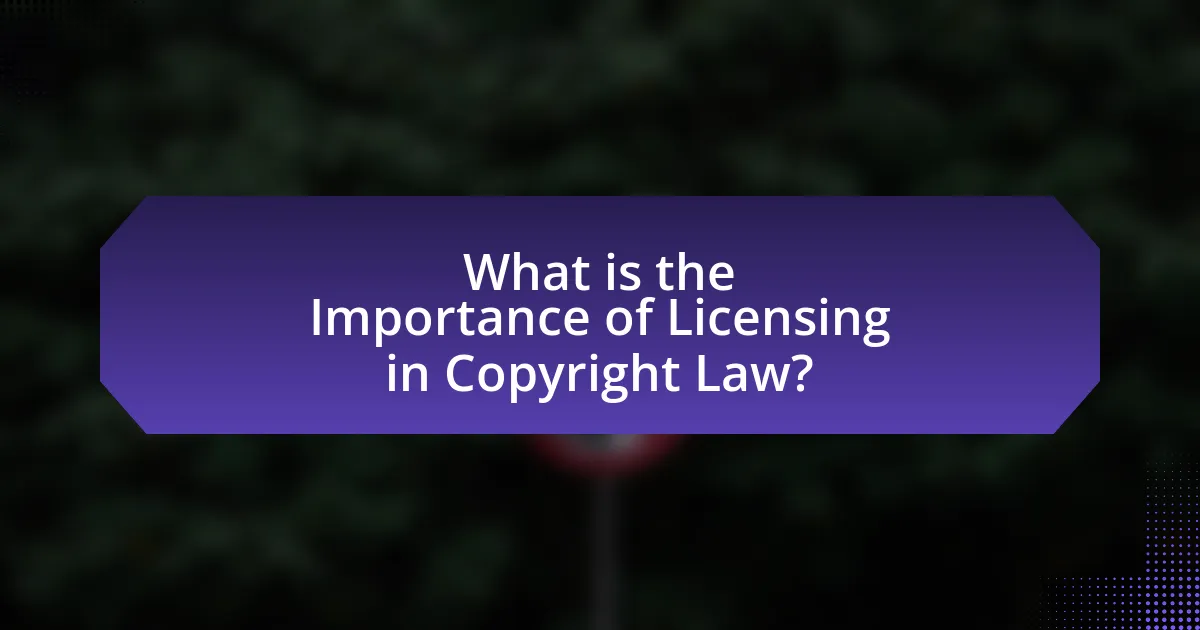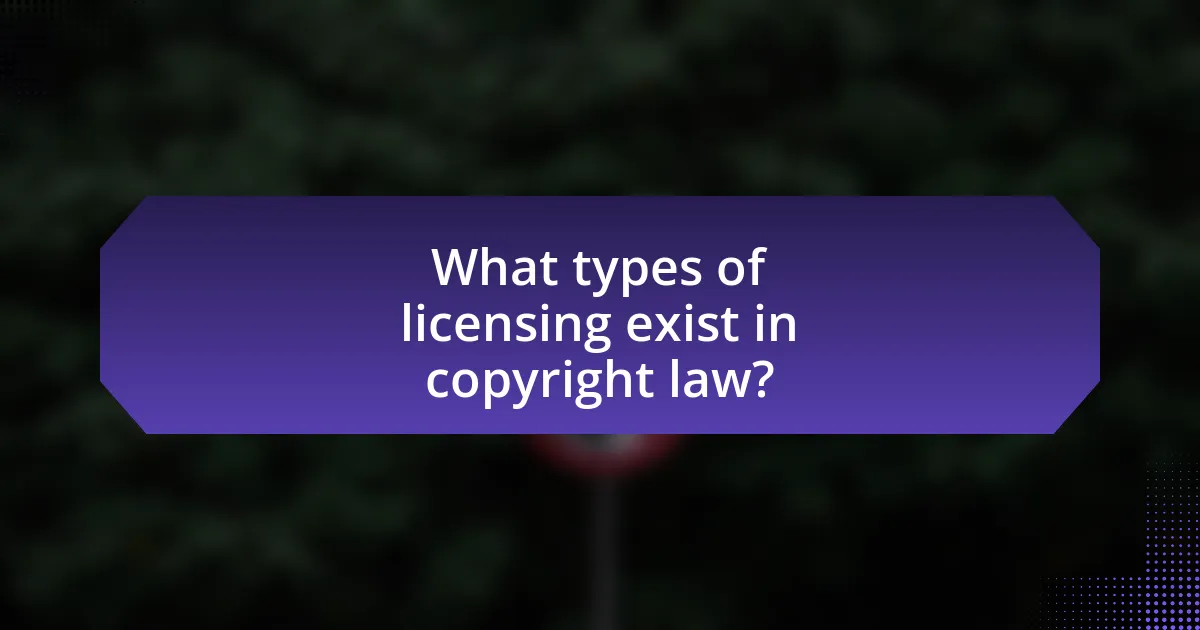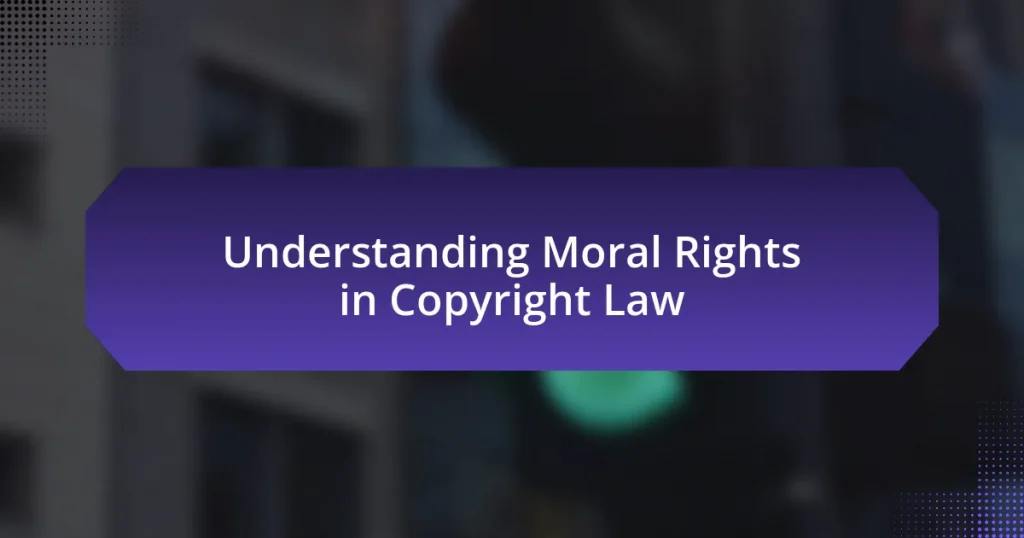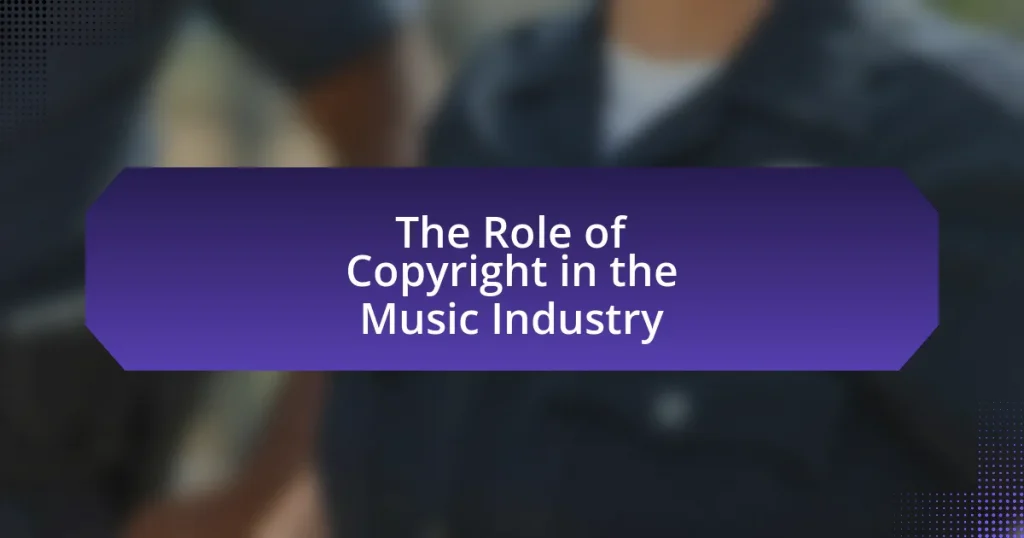Licensing in copyright law is a vital mechanism that allows creators to retain ownership of their works while granting permission for their use, thereby facilitating legal sharing and distribution. This article explores the significance of licensing, detailing how it functions within copyright law, the key elements of licensing agreements, and the protection it offers to creators’ rights. It also examines the financial benefits of licensing, the challenges creators face, and the impact of technology on modern licensing practices. Additionally, the article addresses common misconceptions, best practices for managing licensing agreements, and strategies for preventing disputes, providing a comprehensive understanding of the role of licensing in the creative industry.

What is the Importance of Licensing in Copyright Law?
Licensing in copyright law is crucial as it allows creators to grant permission for the use of their works while retaining ownership. This mechanism facilitates the legal sharing and distribution of creative content, ensuring that creators receive compensation and recognition for their contributions. For instance, licensing agreements can specify terms such as duration, territory, and scope of use, which helps protect the rights of the original creator while enabling others to utilize the work legally. The importance of licensing is underscored by the fact that it generates revenue streams for artists and businesses, contributing to the overall economy of creative industries.
How does licensing function within copyright law?
Licensing within copyright law allows copyright holders to grant permission to others to use their protected works under specified conditions. This legal mechanism enables creators to monetize their intellectual property while retaining ownership rights. For instance, a musician may license a song for use in a film, allowing the filmmaker to use the music while the musician maintains copyright. Licensing agreements can vary in scope, duration, and compensation, reflecting the needs of both parties involved. The U.S. Copyright Act of 1976 provides the framework for these agreements, emphasizing the importance of written contracts to clarify the terms of use and protect the rights of the copyright owner.
What are the key elements of licensing agreements?
The key elements of licensing agreements include the scope of the license, duration, payment terms, and rights and obligations of the parties involved. The scope defines what is being licensed, such as specific intellectual property rights, while duration specifies the time frame for which the license is valid. Payment terms outline any fees or royalties due, and the rights and obligations detail what each party can and cannot do under the agreement. These elements are essential for ensuring clarity and legal enforceability in licensing arrangements, as established in various legal precedents and copyright law guidelines.
How do licensing agreements protect creators’ rights?
Licensing agreements protect creators’ rights by legally granting permission for others to use their intellectual property while retaining ownership. These agreements specify the terms under which the creator’s work can be used, including limitations on usage, duration, and compensation. For instance, a licensing agreement can prevent unauthorized reproduction or distribution of a creator’s work, ensuring that the creator receives credit and financial benefits from their intellectual property. This legal framework is essential in copyright law, as it empowers creators to control how their work is utilized and to seek recourse in case of infringement, thereby safeguarding their economic interests and creative integrity.
Why is licensing crucial for content creators?
Licensing is crucial for content creators because it legally protects their intellectual property and allows them to monetize their work. By obtaining licenses, creators ensure that they retain rights over how their content is used, distributed, and reproduced, which is essential in a digital landscape where unauthorized use is prevalent. For instance, the U.S. Copyright Office reports that licensing agreements can generate significant revenue, with the global licensing market valued at over $250 billion in 2021. This financial incentive underscores the importance of licensing in safeguarding creators’ rights and enabling them to earn from their creations.
What financial benefits does licensing provide to creators?
Licensing provides creators with significant financial benefits, including the ability to generate revenue through royalties and fees. By granting permission for others to use their intellectual property, creators can earn ongoing income without relinquishing ownership. For instance, in the music industry, songwriters can earn royalties each time their work is played on the radio or streamed online, with the global music revenue reaching approximately $23 billion in 2020, largely driven by licensing agreements. Additionally, licensing can open up new markets and opportunities, allowing creators to monetize their work across various platforms and formats, thereby enhancing their overall financial stability.
How does licensing enhance the distribution of creative works?
Licensing enhances the distribution of creative works by providing legal permission for creators to share and monetize their intellectual property. This legal framework allows artists, authors, and musicians to reach broader audiences while retaining control over how their works are used. For instance, licensing agreements can facilitate the use of music in films or advertisements, which can significantly increase exposure and revenue for the creators. According to a report by the International Confederation of Societies of Authors and Composers, licensing can lead to a 30% increase in income for creators by enabling multiple revenue streams through various platforms.
What challenges do creators face regarding licensing?
Creators face several challenges regarding licensing, primarily the complexity of copyright laws and the difficulty in negotiating fair terms. The intricate nature of licensing agreements often leads to misunderstandings about rights and obligations, making it hard for creators to protect their work effectively. Additionally, creators frequently encounter issues with obtaining permissions for using third-party content, which can result in legal disputes or financial penalties. According to a study by the Copyright Office, nearly 60% of creators reported confusion over licensing terms, highlighting the need for clearer guidelines and support in navigating these legal frameworks.
What common misconceptions exist about licensing?
Common misconceptions about licensing include the belief that licensing is the same as ownership, that all licenses are perpetual, and that licenses are universally transferable. Licensing does not confer ownership of the intellectual property; instead, it grants specific rights to use that property under defined conditions. Additionally, many assume that licenses last indefinitely, but most licenses have expiration dates or conditions that can terminate them. Furthermore, the idea that licenses can be freely transferred without consent is incorrect; many licenses include clauses that restrict transferability to protect the rights of the original licensor. These misconceptions can lead to legal disputes and misunderstandings in copyright law.
How can creators navigate licensing disputes?
Creators can navigate licensing disputes by understanding their rights and obligations under copyright law, seeking legal advice, and engaging in open communication with the other party. Knowledge of licensing agreements is crucial, as it allows creators to identify potential infringements and negotiate terms effectively. Legal counsel can provide insights into the nuances of copyright law, helping creators assess the strength of their position. Additionally, maintaining a dialogue with the opposing party can lead to amicable resolutions, such as renegotiating terms or reaching settlements, which can save time and resources compared to litigation.
How does licensing impact the broader creative industry?
Licensing significantly impacts the broader creative industry by providing legal frameworks that enable creators to monetize their work while protecting their intellectual property rights. This legal structure allows artists, musicians, and writers to grant permission for the use of their creations, ensuring they receive compensation and recognition. For instance, the global music licensing market was valued at approximately $5.6 billion in 2020, highlighting the financial importance of licensing in facilitating the distribution and use of creative works. Furthermore, licensing fosters collaboration and innovation, as it allows different creators to build upon existing works, thereby enriching the creative landscape.
What role does technology play in modern licensing practices?
Technology plays a crucial role in modern licensing practices by facilitating the management, distribution, and enforcement of intellectual property rights. Digital platforms enable creators to license their works more efficiently through automated systems that track usage and royalties, ensuring accurate compensation. For instance, blockchain technology provides a transparent and immutable record of transactions, which enhances trust and reduces disputes over licensing agreements. Additionally, advancements in data analytics allow licensors to monitor how their content is used across various platforms, leading to more informed licensing strategies. These technological innovations streamline processes and enhance compliance, ultimately supporting the integrity of copyright law.

What types of licensing exist in copyright law?
In copyright law, the main types of licensing include exclusive licenses, non-exclusive licenses, and compulsory licenses. Exclusive licenses grant the licensee the sole right to use the copyrighted work, preventing the copyright owner from using it or licensing it to others. Non-exclusive licenses allow multiple licensees to use the work simultaneously, enabling the copyright owner to retain rights while granting access to various parties. Compulsory licenses permit use of a copyrighted work without the owner’s consent under specific conditions, often requiring payment of royalties. These licensing types are essential for regulating the use of creative works and ensuring that copyright owners receive compensation for their intellectual property.
What are the differences between exclusive and non-exclusive licenses?
Exclusive licenses grant the licensee sole rights to use the licensed material, meaning the licensor cannot grant the same rights to others, while non-exclusive licenses allow multiple licensees to use the same material simultaneously. Exclusive licenses typically provide greater control and potential for revenue for the licensee, as they are the only party permitted to exploit the rights granted. In contrast, non-exclusive licenses enable the licensor to retain the ability to license the same rights to multiple parties, often resulting in broader distribution and use of the material. This distinction is crucial in copyright law, as it affects the economic and legal rights of both licensors and licensees.
How do exclusive licenses affect the rights of creators?
Exclusive licenses significantly limit the rights of creators by granting specific rights to a licensee, often to the exclusion of the creator. When a creator issues an exclusive license, they typically relinquish their ability to use, distribute, or modify the work in the same manner as the licensee, depending on the terms of the agreement. This means that the creator may lose control over how their work is utilized, potentially impacting their ability to monetize it or to grant further licenses. For instance, if a musician grants an exclusive license to a record label, the label may have the sole right to distribute the music, leaving the musician with limited options for other distribution channels. This dynamic underscores the importance of carefully negotiating the terms of exclusive licenses to protect the creator’s interests while still allowing for commercial opportunities.
What are the implications of non-exclusive licenses for users?
Non-exclusive licenses allow users to access and use copyrighted material without exclusive rights, meaning multiple users can obtain the same license simultaneously. This arrangement provides users with flexibility and broader access to creative works, as they can utilize the material without the constraints of exclusivity. For instance, in the music industry, a non-exclusive license enables various artists to sample a song, fostering collaboration and innovation. Additionally, users benefit from reduced costs, as non-exclusive licenses are often less expensive than exclusive ones, making creative resources more accessible. This model also encourages competition among creators, as it allows for diverse interpretations and adaptations of the original work, ultimately enriching the cultural landscape.
What is the significance of compulsory licensing?
Compulsory licensing is significant because it allows governments to authorize the use of a patented invention without the consent of the patent holder under specific conditions. This mechanism ensures access to essential medicines and technologies, particularly in public health crises, by enabling generic production when the patent owner fails to meet demand or sets prohibitively high prices. For instance, the World Trade Organization’s Agreement on Trade-Related Aspects of Intellectual Property Rights (TRIPS) permits compulsory licensing to promote public health and welfare, demonstrating its role in balancing patent rights with societal needs.
How does compulsory licensing benefit the public?
Compulsory licensing benefits the public by ensuring access to essential products, such as medications, at affordable prices. This mechanism allows governments to authorize the production of patented goods without the consent of the patent holder, particularly in situations where public health is at risk. For instance, during the HIV/AIDS crisis, countries like South Africa implemented compulsory licensing to enable the production of generic antiretroviral drugs, significantly reducing costs and increasing availability. This approach not only promotes public welfare but also encourages competition, leading to innovation and improved quality of products in the market.
What are the limitations of compulsory licensing?
Compulsory licensing has several limitations, including restricted scope, potential for reduced quality, and limited financial compensation for rights holders. The scope of compulsory licensing is often confined to specific circumstances, such as public health emergencies, which may not cover all necessary uses of a work. Additionally, the quality of the licensed product may suffer due to the lack of incentive for the licensee to maintain high standards, as they are not the original creators. Financially, rights holders may receive inadequate compensation, as compulsory licensing typically sets a lower royalty rate than voluntary licensing agreements, impacting their revenue. These limitations highlight the challenges in balancing public interest with the rights of creators in copyright law.

How can creators effectively manage licensing agreements?
Creators can effectively manage licensing agreements by establishing clear terms, maintaining organized documentation, and regularly reviewing agreements for compliance. Clear terms ensure that all parties understand their rights and obligations, which minimizes disputes. Organized documentation allows creators to track agreements, deadlines, and payments, facilitating easier management and reference. Regular reviews help creators stay informed about any changes in laws or market conditions that may affect their agreements, ensuring ongoing compliance and relevance. For instance, a study by the Copyright Office indicates that creators who actively manage their licensing agreements report fewer legal disputes and greater financial success.
What best practices should creators follow when drafting licenses?
Creators should follow clarity, specificity, and legal compliance as best practices when drafting licenses. Clarity ensures that the terms are easily understood, reducing the risk of misinterpretation. Specificity involves detailing the rights granted, limitations, and obligations of all parties involved, which helps prevent disputes. Legal compliance requires adherence to relevant copyright laws and regulations, ensuring that the license is enforceable and protects the creator’s rights. For instance, the U.S. Copyright Act outlines the necessary elements for a valid license, emphasizing the importance of including clear terms to avoid legal challenges.
How can creators ensure their rights are protected in licensing agreements?
Creators can ensure their rights are protected in licensing agreements by clearly defining the terms of use, including scope, duration, and compensation. Specific clauses should outline how the work can be used, any limitations on usage, and the rights retained by the creator. For instance, including a non-exclusive license allows creators to retain ownership while permitting others to use their work under agreed conditions. Additionally, creators should seek legal advice to review agreements before signing, ensuring that their rights are not inadvertently waived. Legal precedents, such as the case of Campbell v. Acuff-Rose Music, Inc., demonstrate the importance of clearly defined rights in protecting creators’ interests.
What resources are available for understanding licensing terms?
Resources available for understanding licensing terms include legal textbooks, online databases, and government websites. Legal textbooks such as “Copyright Law: Essential Cases and Materials” provide foundational knowledge on licensing. Online databases like Westlaw and LexisNexis offer access to case law and legal articles that explain licensing terms in detail. Additionally, government websites, such as the U.S. Copyright Office, provide official guidelines and resources that clarify licensing requirements and processes. These resources collectively enhance comprehension of licensing terms in copyright law.
What common pitfalls should creators avoid in licensing?
Creators should avoid the common pitfalls of unclear terms, inadequate research, and neglecting to register their licenses. Unclear terms can lead to misunderstandings about rights and obligations, resulting in disputes. Inadequate research may cause creators to overlook existing licenses or similar works, which can lead to infringement issues. Additionally, neglecting to register licenses can hinder the ability to enforce rights, as registration often provides legal advantages in copyright disputes. These pitfalls can significantly impact a creator’s ability to protect their work and monetize it effectively.
How can misunderstandings about licensing lead to legal issues?
Misunderstandings about licensing can lead to legal issues by causing individuals or organizations to use copyrighted material without proper authorization. When a user misinterprets the terms of a license, such as assuming that a work is free to use when it is not, they may infringe on the copyright holder’s rights. This can result in lawsuits, financial penalties, and the requirement to cease the unauthorized use of the material. For instance, a study by the Copyright Office indicates that copyright infringement cases often arise from a lack of clarity regarding licensing agreements, highlighting the necessity for clear communication and understanding of licensing terms to avoid legal complications.
What steps can creators take to prevent licensing disputes?
Creators can prevent licensing disputes by clearly defining the terms of use for their work and ensuring all agreements are documented in writing. Establishing explicit licensing agreements that outline the scope, duration, and compensation helps mitigate misunderstandings. Additionally, creators should conduct thorough research to confirm that their work does not infringe on existing copyrights, as demonstrated by the U.S. Copyright Office’s guidelines which emphasize the importance of originality and proper attribution. Regularly consulting with legal professionals specializing in copyright law can further safeguard against potential disputes.
What practical tips can help creators navigate licensing successfully?
Creators can navigate licensing successfully by understanding the specific terms of licenses, seeking legal advice when necessary, and keeping thorough documentation of all agreements. Familiarity with different types of licenses, such as Creative Commons or exclusive licenses, allows creators to choose the best option for their work. Legal advice ensures compliance with copyright laws and helps avoid potential disputes. Additionally, maintaining detailed records of licensing agreements, including dates, parties involved, and terms, provides clarity and protection in case of future conflicts. These practices are essential for safeguarding intellectual property and maximizing its value.



